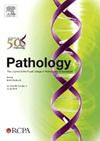Progression to invasive carcinoma: cellular activities and immune-related pathways define the lepidic and acinar subtypes of lung adenocarcinoma
IF 3
3区 医学
Q1 PATHOLOGY
引用次数: 0
Abstract
Lung adenocarcinoma (LUAD) is the most frequent subtype of thoracic malignancy, which is itself the largest contributor to cancer mortality. The lepidic subtype is a non-invasive tumour morphology, whereas the acinar subtype represents one of the invasive morphologies. This study investigates the transition from a non-invasive to an invasive subtype in the context of LUAD. Patients with pathologically confirmed mixed subtype LUAD consented to analysis of RNA sequencing data extracted from each subtype area separately. The study included 17 patients with tumours found to exhibit a lepidic-acinar transition. Eighty-seven genes were found to be differentially expressed between the lepidic and acinar subtypes, with 44 genes significantly upregulated in lepidic samples and 43 genes significantly upregulated in acinar samples. Gene Ontology analysis showed that many of the genes upregulated in the acinar subtype were related to immune response, whereas for the lepidic subtype, genes responsible for cellular activities were upregulated. Immune deconvolution analysis showed that there was a significantly higher proportion of M1 macrophages and total B cells in acinar areas. Immunohistochemistry showed that B cells were mainly localised to tertiary lymphoid structures in the tumour area. This is the first study to investigate the molecular features of mixed subtype lepidic-acinar transitional tumours. Immunological dynamics are presumed to be involved in this transition from lepidic to acinar subtype. Further research should be conducted to elucidate the progression of disease from non-invasive to invasive morphologies.
发展为浸润性癌:细胞活动和免疫相关途径决定了肺腺癌的鳞状亚型和尖状亚型。
肺腺癌(LUAD)是最常见的胸部恶性肿瘤亚型,它本身就是癌症死亡率的最大贡献者。鳞状亚型是一种非侵袭性肿瘤形态,而腺泡亚型则代表一种侵袭性形态。本研究探讨了LUAD从非侵入性亚型到侵入性亚型的转变。病理证实的混合亚型LUAD患者同意分别分析从每个亚型区域提取的RNA测序数据。该研究包括17例发现肿瘤呈腺泡-腺泡过渡的患者。87个基因在鳞状细胞亚型和腺泡亚型之间存在差异表达,其中44个基因在鳞状细胞样本中显著上调,43个基因在腺泡样本中显著上调。基因本体论分析显示,在腺泡亚型中,许多上调的基因与免疫应答有关,而在鳞状亚型中,上调的基因与细胞活性有关。免疫反褶积分析显示,腺泡区M1巨噬细胞和总B细胞比例明显升高。免疫组化显示B细胞主要分布于肿瘤区域的三级淋巴结构。这是首次研究混合亚型鳞状腺泡移行性肿瘤的分子特征。免疫动力学被认为参与了从卵泡病毒亚型到腺泡病毒亚型的转变。需要进一步的研究来阐明疾病从非侵入性到侵入性形态的进展。
本文章由计算机程序翻译,如有差异,请以英文原文为准。
求助全文
约1分钟内获得全文
求助全文
来源期刊

Pathology
医学-病理学
CiteScore
6.50
自引率
2.20%
发文量
459
审稿时长
54 days
期刊介绍:
Published by Elsevier from 2016
Pathology is the official journal of the Royal College of Pathologists of Australasia (RCPA). It is committed to publishing peer-reviewed, original articles related to the science of pathology in its broadest sense, including anatomical pathology, chemical pathology and biochemistry, cytopathology, experimental pathology, forensic pathology and morbid anatomy, genetics, haematology, immunology and immunopathology, microbiology and molecular pathology.
 求助内容:
求助内容: 应助结果提醒方式:
应助结果提醒方式:


